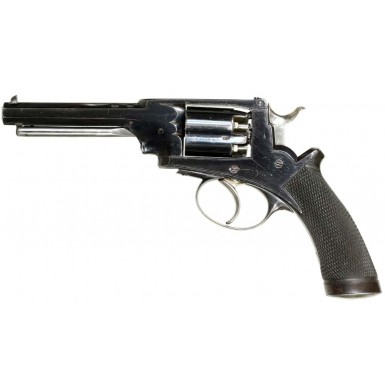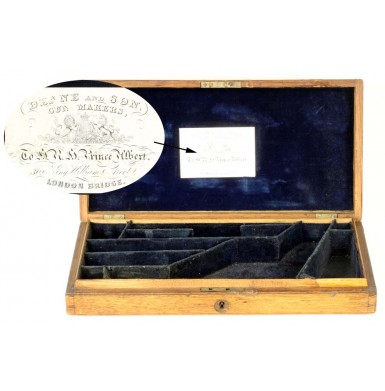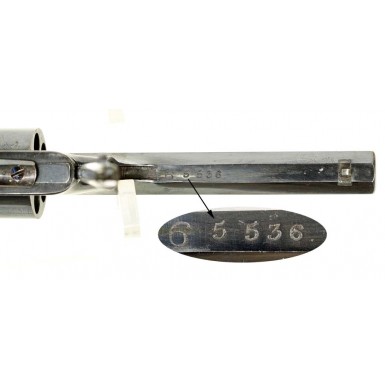Cased Deane-Harding Pocket Revolver - Excellent
- Product Code: FHG-2019-SOLD
- Availability: Out Of Stock
-
$1.00
This is an EXCELLENT example of one of the Deane Harding, percussion revolver, one of the less often-encountered English pistols of the mid-19th Century. The Deane Harding revolver was produced by the firm of Deane & Son of London from 1858 through the late 1860s and the demise of the age of percussion revolvers. The pattern then continued to be produced as a cartridge revolver until about 1873. During its production, the Deane Harding competed directly with the major English revolver designs of the period, including Adams, Kerr, Tranter and Webley. In the ever-sordid world of English gun makers, the relationship of Deane with other notables in the trade looks more like a soap opera than a normal series of business relationships.
John Deane was one of Robert Adams' original partners in the production of the famous Adams percussion revolver. The initial production guns were produced by their firmDeane, Adams & Deane at Deane's 30 King William Street shop. There they produced the M1851 Pattern Adams revolver as well as the later, improved Beaumont Adams M1854 revolvers. Adams was subsequently hired by the London Armory Company and the rights to produce his revolvers were purchased by the L.A. Co as well. At that time, the London Armoury Company also issued 125 shares of stock in their company to Deane as compensation for his portion of the now severed Deane-Adams partnership. Around 1857, Deane saw the Adams and London Armory relationship souring. He sold his shares in the company and went back into business for himself under the name of Deane & Son. Deane retained his 30 King William Street shop and hired James William Harding as his company manager and superintendent. Harding had recently patented a new revolver frame and loading lever, and together he and Deane started production of what became known as the Deane-Harding revolver.
Harding's patent was for a two-piece frame that hinged together via a hook shaped wedge at the lower end of the frame, forward of the cylinder. By removing the screw at the top rear of the frame that secured the safety arm to the right side of the frame, the barrel could then be depressed and the upper frame un-hooked from the lower frame. The break down system is nearly identical to that of a US M1858 Starr Revolver, only without the hinge at the bottom of the frame. Harding had also patented a loading lever that was quite similar to the Colt style hinged loading lever, which mounted under the barrel. Deane primarily produced the guns in 54 Bore (.443 caliber), with the hope of obtaining military contracts. However, due primarily to some bad press, the revolver never became particularly popular and simply never gained the level of acceptance of the Adams and Tranter designs. At least one noted user of the revolver at the time, a Lord Roberts, noted in THE FIELD (an English firearms periodical of the time) that the gun "could always be depended upon to malfunction at a critical moment". Such faint praise did not help Deane to compete with his much more established rivals. Deane was forced to find customers where he could and as such turned to the commercial trade to sell guns to anyone who would buy them. By the early 1860s, as a cost saving measure, Deane had turned to the Birmingham trade to produce the guns for him at a lower cost to improve his profit margin.
The Cased Deane-Harding Pocket Revolver offered here is in EXCELLENT condition and is one of his early guns as it is London and not Birmingham proved. It retains its original casing, as well as several accessories. The gun is nicely sized, at about 9 “" in overall length, making is small enough for pocket carry and yet large enough to feel like a substantial revolver in the hand. The top strap is engraved in a single line: DEANE & SON LONDON BRIDGE.. The right side of the frame is engraved in one line: DEANE-HARDING PATENT No 5536L. The cylinder is also engraved with the matching serial number No 5536L. The matching serial number, 5536 is stamped on the bottom flat of the octagonal barrel and is preceded by what appears to be an assembly number, a large 6. A similar 6 is also stamped on the rear of the cylinder, on one of the wings that separates the cones (nipples) between the chambers. London proof marks appear on the left upper angled flat of the barrel, forward of the frame juncture and on the cylinder between the chambers. The gun functions perfectly when held with the muzzle angled down, with both the single action and double action mechanisms functioning correctly. However, the revolver will not always function when held level and never when the barrel is facing upward, suggesting that the hand spring is broken or damaged. This would be a perfect example of "Lord Roberts" scathing criticism of the mechanical fragility of the design. When the action does function, the timing, indexing and lock up of the cylinder is perfect.
The gun retains about 90%+ bright blued finish on the 4 “" octagonal barrel and frame and a similar amount of original brightly blued finish, as does the 5-shot cylinder. The majority of the finish loss is on the triggerguard and buttcap, which both show wear and thinning. Any loss on the frame and barrel is primarily thinning along high edges and contact points, as would be expected. The trigger, hammer and loading lever are both bright and appear to have been finished "in the white" originally. The loading lever is complete and original, and functions exactly as it should. The original frame mounted safety lever is in place on the upper right side of the frame and functions correctly. The safety hook retains much of its original bright nitre or fire blued finish with a purplish hue, and most of the screws retain at least some of this finish as well. The safety is essentially an inverted version of the safety found on later model Tranter patent revolvers. The screw that holds the safety in place, and also holds the rear part of the topstrap to the upper rear part of the frame has had its head broken. This was likely from trying to force the screw out, and then the broken shaft was lightly peened to hold the safety in place. In order to take the gun apart, this screw would have to be removed and realistically a new one put in its place. The bore of the revolver measures about .332", making it a 120-bore gun. The bore is in about VERY FINE condition. It is mostly bright and retains crisp three-groove rifling, with some lightly scattered pinpricking along its length, mostly in the grooves. The original cones (nipples) are all present and remain in very crisp condition. The original dovetail mounted front sight blade is in place at the end of the barrel as well. The checkered walnut grips are in about EXCELLENT condition with no chips, breaks or cracks. They show only some minor handling marks and light wear, but in general all of the checkering remains very crisp and sharp.
The revolver is contained in a correct pattern, original English oak retailer's casing with an original Deane & Son label in the lid. The label measures about 3 11/16" wide by 2 3/8" in height and reads in five lines:
DEANE and SON.
GUN MAKERS,
To H.R.H. Prince Albert.
30 King William Street
LONDON BRIDGE.
The case is lined in dark blue cloth, which appears to be original to the period of the casing. The case itself shows moderate wear on the exterior and the brass lock escutcheon as well as the lock internals are missing from the case. The case has the usual round brass plate inset in the top for the engraving of a name, initials or a presentation. This disk is blank. The case remains solid, with some minor looseness and some minor damage to the interior compartment dividers and some obvious age wear to the lower portion of the blue lining. A set of four green felt feet have been attached to the bottom of the case. The casing contains an assortment of tools and accouterments for display with the revolver. As it usual, the accouterments appear to be a combination of original accessories and later added items to round out the display. The casing includes the following:
1) Dual Cavity Brass Bullet Mold. The mold is unmarked but of the correct patter to cast a pair of conical, flat base bullets with a pair of grease grooves. The profile it typical of London pistol bullets of the period used by makers like Kerr. The mold appears to be original to the casing, as it is the correct pattern and casts bullets that measure about .339", correct for this revolver. The mold is in VERY FINE condition, with a lovely, untouched ocher patina, bright, crisp cavities and a sprue cutter that retains much of its original blue.
2) A number of bullets cast from the mold. A total of 17 bullets, cast from this mold are present in the casing, all in GOOD to VERY GOOD condition.
3) A period English pistol powder flask by Hawksley. The flask is marked on the top of the cap, in two lines: C&J.W / HAWKSLEY. The flask is adjustable, throwing charges of 3/16, “ and 5/16 drams of powder. The adjustable spout functions correctly. The flask is in VERY GOOD to NEAR FINE condition, with the only issue noted being that the charger spring is broken, a piece that can be easily replaced if so desired.
4) A period English cleaning rod. The rod is made of rosewood, measuring just under 7" in length with brass fittings and removable cleaning jag that reveals a ball screw to pull unfired bullets from the cylinder. The rod remains in VERY FINE condition and fits the casing well enough that it could be original to the set.
5) A period jappaned tin of Eley Brother pistol percussion caps. The tin is in about GOOD+ condition, but the lid is damaged and will not seat securely on the tin. Some original caps are contained in the tin, which will not be included if the set is shipped to the new owner, as these are considered explosive and can only be shipped via ground service with special handling tags. The paper label remains quite legible and the tin is a nice addition to the set.
6) A contemporary ebony handled turnscrew (screwdriver).. This is of more recent vintage, is not period, and has been added to the set for display purposes. It remains in FINE condition and adds nicely to the display of the revolver.
7) A contemporary ebony handled cone wrench. This is of more recent vintage, is not period, and has been added to the set for display purposes. It remains in FINE condition and adds nicely to the display of the revolver.
8) A key for the case lock. The key appears to be period and is in FINE condition, but the lock mechanism is no longer present in the case.
Taken as a hole, the included accessories display very nicely and only add to the fine appearance of this high condition revolver in its original Deane & Son casing.
Overall this is a really outstanding and complete example of one of the less often encountered English percussion revolvers of the Civil War era. The majority of the Deane-Harding production was large frame, double action service caliber revolvers and pocket-sized revolvers were only a small part of the company's production. While no formal period documentation of the importation of these guns during the Civil War is known, it appears likely from a small group of extant examples that at least a handful were imported speculatively by the South, and no doubt some were imported by retailers before the war, both North and South. These are scarce revolvers that are difficult to find cased and in such fine condition. This will be a wonderful addition to your collection of English percussion revolvers from the mid-19th century.
SOLD











